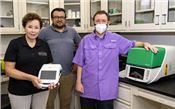New Equipment Expands Research, Diagnostic Capabilities At The Arkansas Plant Health Clinic

Sherrie Smith, director of the Arkansas Plant Health Clinic, left, stands with Alejandro Rojas, assistant professor of plant pathology, and program associate Jason Pavel.
U of A System Division of Ag photo by Fred Miller
BRITTANEY MANN
FAYETTEVILLE, ARKANSAS
New diagnostic equipment at the University of Arkansas System Division of Agriculture’s Arkansas Plant Health Clinic is helping expand its research and detection capabilities.
Alejandro Rojas, assistant professor of soilborne pathology and ecology at the Arkansas Agricultural Experiment Station, the Division of Agriculture’s research arm, is using a qPCR diagnostic instrument to focus on specialty crops and Phytophthora species as a steppingstone into researching more plant pathogens.
“The idea with the project was to, one, start building up resources in the diagnostic lab, so we can better identify those Phytophthora species that are causing disease,” Rojas said. “And two, by doing that, we can start looking at what kind of problems are more common for growers and go a little bit deeper into those.”
The equipment also advances the diagnostic capabilities of the Arkansas Plant Health Clinic, a diagnostic service unit of the division’s Cooperative Extension Service.
The new equipment
The qPCR – quantitative polymerase chain reaction – instrument uses a process similar to COVID-19 diagnostic testing. The machine quickly replicates extracted DNA, detects plant pathogens and differentiates between those species when the researchers add specific primers – short single-stranded DNA sequences.
The diagnostic clinic also acquired an isothermal amplification tool that uses crushed-up plant material and runs cycles determined by a scanned barcode to quickly replicate and detect a specific pathogen’s DNA. A positive or negative symbol indicates the results.
The qPCR instrument takes a bit longer than the amplifier but offers more specific information about the plant pathogens, Rojas said.
The traditional methods would give only a positive or negative reading for Phytophthora, but the sensitivity could lead to more false positives, Rojas said. For samples of major concern, DNA has to be extracted and sent to a licensed outside lab to confirm the results.
That could eventually change with the new capabilities.
“By getting access to this kind of equipment, in the future, hopefully, we can be able to do all the process here and confirm the samples,” Rojas said.
The Arkansas Plant Health Clinic is not yet licensed to verify if a sample is Phytophthora ramorum (a species of major concern), but it plans to apply for one.
Enhanced service
The qPCR instrument and its detailed results will help the diagnosticians provide better guidance to growers.
“This new machine will differentiate which species (of Phytophthora) it is, which can be useful,” said Sherrie Smith, director of the Arkansas Plant Health Clinic. “Basically, the treatment is the same no matter which species it is, but there are some crops that have more resistance to one Phytophthora than to another one.”
Making the distinction among species is important to know how to best help the growers, Smith said.
Jason Pavel, program associate for the Plant Health Clinic, has noticed time reductions when conducting tests with the amplification machine.
“The machine itself takes between 20 and 30 minutes depending on the type of pathogen we are testing for,” Pavel said. It has saved him time because some of the other methods could take anywhere from a few hours to waiting overnight for results.
The Plant Health Clinic has found the amplifier tests for rose rosette virus and Xylella the most useful so far.
“We love the amplifier machine because the method that we were using, a molecular method to detect rose rosette virus, took a good day-and-a- half to do the procedure,” Smith said. It takes no more than an hour to run the test now.
Research focus
Phytophthora species, types of water molds, cause many plant diseases, including late blight – the cause of the Irish Potato Famine – buckeye rot and sudden oak death, Smith said.
When late blight infects the crop or when the clinic gets the sample, it is usually too late for treatment, Smith said. Some chemicals can treat the disease, but it must be caught early to be effective.
Producers can mitigate the risk by planting resistant cultivars, Smith said.
Rojas focuses much of his attention on Phytophthora, and his research may lead to other disease prevention mechanisms.
Many research questions can be answered with the new devices, Rojas said. For example, they could study the presence of a pathogen in different soil types and discover improved management recommendations.
The new resources will also open more research opportunities in ecology or epidemiology, Rojas said.
One of Rojas’ graduate students is developing a diagnostic test for taproot decline, a disease in soybeans, Rojas said. Another student is also working on culturing Phytophthora from the clinic samples so the researchers can investigate the species more thoroughly.
The Arkansas Plant Health Clinic is part of a network of nationwide clinics, Rojas said. And that offers both research and extension advantages.
“Any method another lab is using, we have the possibility to adapt it,” Rojas said. “And (the clinic) can use it and start providing the service to the growers.”
The purchase of the qPCR instrument was supported through funding from the U.S. Department of Agriculture’s Specialty Crop Block Grant Program and support from the Division of Agriculture through infrastructure funds. An emergency mini-grant from The Southern Plant Diagnostic Network helped purchase the isothermal amplification tool.
The team behind the grants included: Rojas, Smith, Keiddy Urrea- Morawicki, former diagnostician for the Arkansas Plant Health Clinic, and Ken Korth, head of the department of entomology and plant pathology for the Division of Agriculture and the Dale Bumpers College of Agricultural, Food and Life Sciences. ∆
BRITTANEY MANN: University of Arkansas